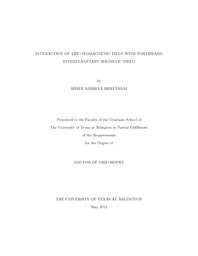
ATTENTION: The works hosted here are being migrated to a new repository that will consolidate resources, improve discoverability, and better show UTA's research impact on the global community. We will update authors as the migration progresses. Please see MavMatrix for more information.
Show simple item record
| dc.contributor.author | Bhattarai, Shree K. | en_US |
| dc.date.accessioned | 2013-07-22T20:15:15Z | |
| dc.date.available | 2013-07-22T20:15:15Z | |
| dc.date.issued | 2013-07-22 | |
| dc.date.submitted | January 2013 | en_US |
| dc.identifier.other | DISS-11895 | en_US |
| dc.identifier.uri | http://hdl.handle.net/10106/11881 | |
| dc.description.abstract | The interaction of the solar wind with Earth's magnetic field causes the transfer of momentum and energy from the solar wind to geospace. The study of this interaction is gaining significance as our society is becoming more and more space based, due to which, predicting space weather has become more important. The solar wind interacts with the geomagnetic field primarily via two processes: viscous interaction and the magnetic reconnection. Both of these interactions result in the generation of an electric field in Earth's ionosphere. The overall topology and dynamics of the magnetosphere, as well as the electric field imposed on the ionosphere, vary with speed, density, and magnetic field orientation of the solar wind as well as the conductivity of the ionosphere. In this dissertation, I will examine the role of northward interplanetary magnetic field (IMF) and discuss the global topology of the magnetosphere and the interaction with the ionosphere using results obtained from the Lyon-Fedder-Mobarry (LFM) simulation. The electric potentials imposed on the ionosphere due to viscous interaction and magnetic reconnection are called the viscous and the reconnection potentials, respectively. A proxy to measure the overall effect of these potentials is to measure the cross polar potential (CPP). The CPP is defined as the difference between the maximum and the minimum of the potential in a given polar ionosphere. I will show results from the LFM simulation showing saturation of the CPP during periods with purely northward IMF of sufficiently large magnitude. I will further show that the viscous potential, which was assumed to be independent of IMF orientation until this work, is reduced during periods of northward IMF. Furthermore, I will also discuss the implications of these results for a simulation of an entire solar rotation. | en_US |
| dc.description.sponsorship | Lopez, Ramon E. | en_US |
| dc.language.iso | en | en_US |
| dc.publisher | Physics | en_US |
| dc.title | Interaction Of The Geomagnetic Field With Northward Interplanetary Magnetic Field | en_US |
| dc.type | Ph.D. | en_US |
| dc.contributor.committeeChair | Lopez, Ramon E. | en_US |
| dc.degree.department | Physics | en_US |
| dc.degree.discipline | Physics | en_US |
| dc.degree.grantor | University of Texas at Arlington | en_US |
| dc.degree.level | doctoral | en_US |
| dc.degree.name | Ph.D. | en_US |
Files in this item
- Name:
- Bhattarai_uta_2502D_11895.pdf
- Size:
- 8.866Mb
- Format:
- PDF
This item appears in the following Collection(s)
Show simple item record


